Tail of Spence
Tail of Spence
The Tail of Spence, also known as the axillary tail, is an extension of the breast tissue that extends into the axilla (armpit). It is named after the Scottish surgeon James Spence, who first described this anatomical feature. The Tail of Spence is significant in the context of breast cancer and other breast-related pathologies, as it is a common site for the spread of malignant cells.
Anatomy[edit | edit source]
The Tail of Spence is a triangular area of breast tissue that extends from the upper outer quadrant of the breast into the axilla. It is composed of the same glandular, connective, and fatty tissues found in the rest of the breast. The presence of this extension means that breast tissue can be found in the axillary region, which is important for both clinical examination and imaging studies.
Clinical Significance[edit | edit source]
The Tail of Spence is clinically significant for several reasons:
- It is a common site for the development of breast cancer.
- During a breast examination, it is important to palpate the Tail of Spence to check for any abnormalities.
- In breast imaging techniques such as mammography and ultrasound, the Tail of Spence must be included to ensure a comprehensive evaluation of the breast tissue.
Pathology[edit | edit source]
The Tail of Spence can be involved in various pathological conditions, including:
- Breast cancer: Malignant cells can spread to the Tail of Spence, making it a critical area to examine during cancer screenings.
- Mastitis: Inflammation of the breast tissue can extend into the Tail of Spence, causing pain and swelling in the axillary region.
- Fibrocystic breast changes: Benign changes in the breast tissue can also affect the Tail of Spence, leading to lumps or cysts that may be palpable during a clinical examination.
Examination[edit | edit source]
During a clinical breast examination, healthcare providers should include the Tail of Spence in their assessment. This involves palpating the axillary region to check for any lumps, tenderness, or other abnormalities. Proper examination techniques are crucial for early detection of breast cancer and other breast-related conditions.
Imaging[edit | edit source]
Imaging studies such as mammography, ultrasound, and MRI should include the Tail of Spence to ensure a thorough evaluation of the breast tissue. Radiologists must be aware of this anatomical feature to avoid missing any potential abnormalities.
Surgical Considerations[edit | edit source]
In breast surgery, particularly in procedures such as mastectomy or lumpectomy, the Tail of Spence may need to be addressed. Surgeons must be aware of its presence to ensure complete removal of malignant tissue and to minimize the risk of recurrence.
History[edit | edit source]
The Tail of Spence is named after James Spence, a 19th-century Scottish surgeon who first described this anatomical feature. His contributions to the understanding of breast anatomy have had a lasting impact on the field of breast surgery and oncology.
See Also[edit | edit source]
Search WikiMD
Ad.Tired of being Overweight? Try W8MD's physician weight loss program.
Semaglutide (Ozempic / Wegovy and Tirzepatide (Mounjaro / Zepbound) available.
Advertise on WikiMD
|
WikiMD's Wellness Encyclopedia |
| Let Food Be Thy Medicine Medicine Thy Food - Hippocrates |
Translate this page: - East Asian
中文,
日本,
한국어,
South Asian
हिन्दी,
தமிழ்,
తెలుగు,
Urdu,
ಕನ್ನಡ,
Southeast Asian
Indonesian,
Vietnamese,
Thai,
မြန်မာဘာသာ,
বাংলা
European
español,
Deutsch,
français,
Greek,
português do Brasil,
polski,
română,
русский,
Nederlands,
norsk,
svenska,
suomi,
Italian
Middle Eastern & African
عربى,
Turkish,
Persian,
Hebrew,
Afrikaans,
isiZulu,
Kiswahili,
Other
Bulgarian,
Hungarian,
Czech,
Swedish,
മലയാളം,
मराठी,
ਪੰਜਾਬੀ,
ગુજરાતી,
Portuguese,
Ukrainian
Medical Disclaimer: WikiMD is not a substitute for professional medical advice. The information on WikiMD is provided as an information resource only, may be incorrect, outdated or misleading, and is not to be used or relied on for any diagnostic or treatment purposes. Please consult your health care provider before making any healthcare decisions or for guidance about a specific medical condition. WikiMD expressly disclaims responsibility, and shall have no liability, for any damages, loss, injury, or liability whatsoever suffered as a result of your reliance on the information contained in this site. By visiting this site you agree to the foregoing terms and conditions, which may from time to time be changed or supplemented by WikiMD. If you do not agree to the foregoing terms and conditions, you should not enter or use this site. See full disclaimer.
Credits:Most images are courtesy of Wikimedia commons, and templates, categories Wikipedia, licensed under CC BY SA or similar.
Contributors: Prab R. Tumpati, MD

